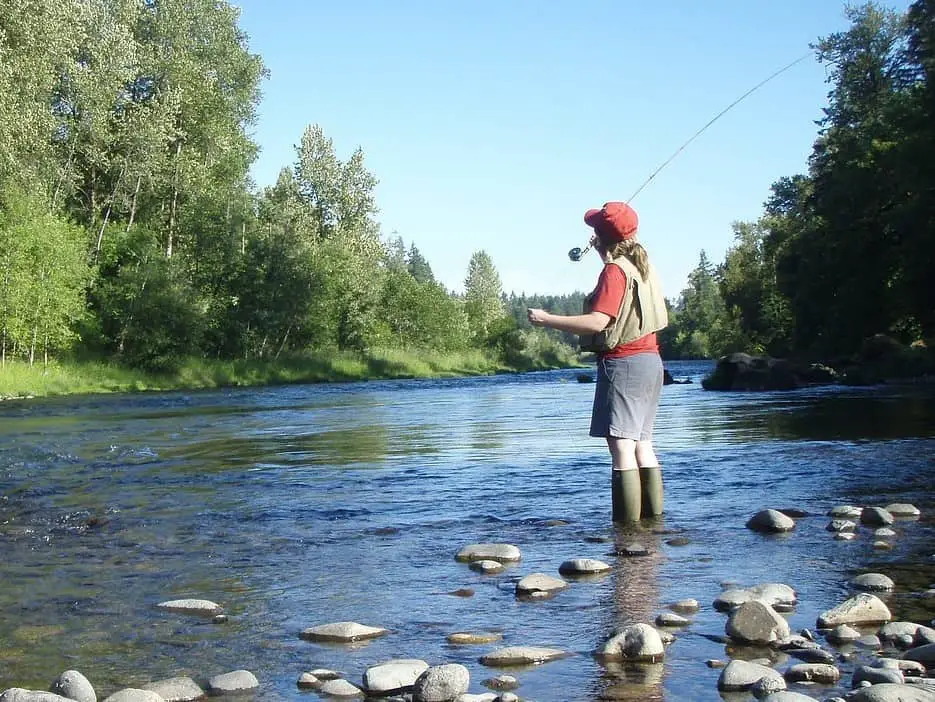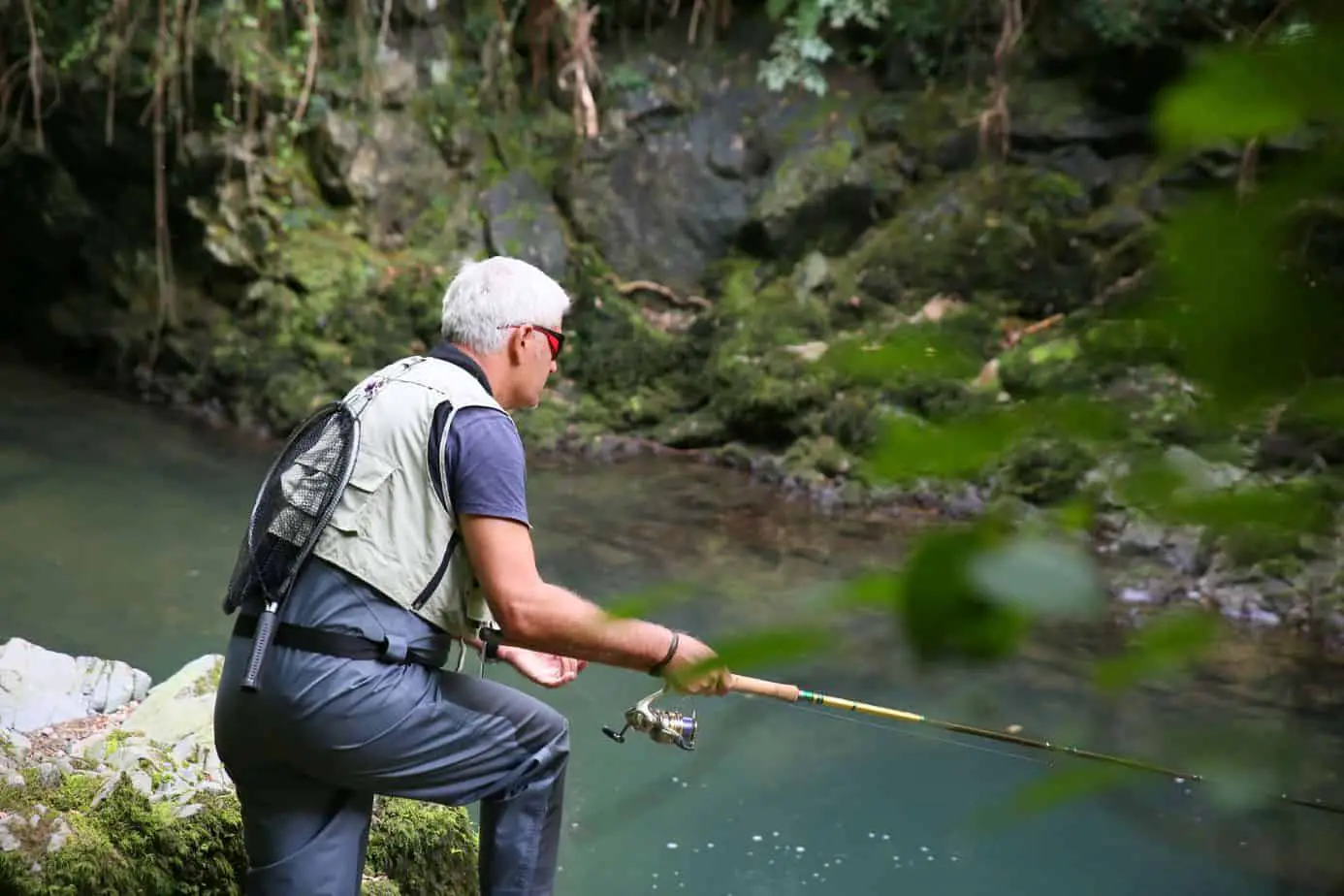Summer brings a lot of joy to many people. Going swimming, throwing parties, and barbequing are just a few of the summer’s biggest perks. One incredible way to spend a summer is with fly fishing. Of all the types and styles of fishing, fly fishing is one of the best for connecting with nature and enjoying the outdoors.
If you choose to fly fish in the summer, there are a few different factors than when you go during any other season. The biggest of which is your clothing.
When fly fishing in the summer, wear:
- Polyester Shirt, long sleeve and breathable
- Nylon Pants, quick-drying
- Neck Gaiter
- Waders or Boots
- Rain Gear, if necessary
- Storage Vest
Knowing what to wear when fly fishing in the summer is crucial for your success and enjoyment of the experience. Having a knowledge base of information about the appropriate attire and taking your fly fishing excursion to the next level.
Here is a guide for what to wear the next time you go fly fishing in the summer.
Base Layer
No matter the season, you need a solid base layer. However, this section of clothing often gets overlooked in the summer. Because it can get sweltering in many areas, most people don’t think having a base layer is important.
A base layer is the first thing you put on other than your underwear. For your top half, it is as simple as a polyester t-shirt. In the summer months, you probably don’t need thick thermals because you will quickly overheat. You also want to stay away from cotton because this material soaks up all moisture and does not wick it away from your body.
We LOVE these Columbia PFG Long Sleeve Shirts. They are breathable and moisture-wicking. The sleeves can roll up or down to protect you from the sun or insects.
On the bottom, your pants can be considered your base layer. You probably don’t want long underwear when it is 80+ degrees outside. So, having a trusted pair of pants is a gamechanger. Nylon or polyester are great options for materials that dry quickly and will keep you cool.
Sun Protectants
The next layer is where protection from the elements comes into play. In the summer, the sun is your biggest obstacle. Without protecting yourself from the sun, your trip can be derailed very quickly.
On top of your base layer, you could have a long sleeve, lightweight shirt that is both protective and breathable. Just about every outdoor apparel brand has this shirt style, but we really love the PFG line from Columbia. It may seem weird to wear long sleeves in the summer, but this is great for sun protection.
Another big sun protectant that you can wear is a hooded t-shirt. These usually are similar to the previous shirts, but they have a hood attached. This allows you to cover your ears, neck, and head from the sun.
If the hood isn’t your style, a neck gaiter will do the trick. These are probably the most popular sun protectant on the market. These are tubes of protective material that blocks the sun from getting to your neck. Then, you can stretch it up over your head and cover everything.
Nothing can derail a fly fishing trip like a horrible sunburn. You need to take it seriously to protect yourself and fully enjoy the fishing experience.

Waders And Boots
Although it may seem tempting to jump in the creek and enjoy the cool water during a hot summer day, this isn’t always the smartest idea. Water can be deceivingly cold and potentially dangerous. Some of the US’ best fly fishing happens in some icy mountain streams.
The most common remedy for this in the summer is a pair of lightweight waders.
Waders are gear that you wear over everything else and possess a barrier between you and the water. Waders are made of waterproof materials and are great for keeping your lower half dry.
Unlike a lot of fishing styles, fly fishing often happens in the water. You usually aren’t on a boat or the shore. Being in the water allows you to set up better casts and connect with nature on another level.
If you’re wondering where else you can fly fish, read “Can You Fly Fish Anywhere?”
So, you are more likely to be exposed to the water system when throwing a fly. Waders provide excellent protection from the water and some of the obstacles below the surface.
They come in two main styles: hip and overalls. Hip waters go up to the waistline and are worn similar to pants. Overalls have straps that go over the shoulders and increase the surface area covered by a few inches. Overall, waders will bring the protection up to your chest, whereas the hip waders stop at the waist.
For the summer months, you can invest in a lighter pair of waders. There are thick, insulated models out there, but those won’t be necessary for the summer.
Most of these wader styles will come with built-in boots, so the waterproofing is maxed out. But, sometimes, big, heavy waders aren’t always needed. Especially in shallow water, you might just want boots.
Wader boots are waterproof boots with the same wader materials as the full options extended up, usually to the hip. This takes away a lot of the bulk that comes with the use and storage of traditional waders.
Especially in the summer, boot waders may be the way to go because they offer more breathability, so you don’t overheat.
Rain Gear
Nothing can ruin a great fishing trip quicker than rain. Rain isn’t always bad, but it can be when you aren’t adequately prepared. Even in the summer, the rain can be bone-chilling and cold enough to send you home shivering.
Especially in the summer, understanding your local climate and forecast is important. Yes, it can be 80 degrees outside, but when a front rolls in, the temperature could drop 20 degrees, and cold rain can fall upon you. This is why you have to be prepared, even in the hot summer months.
Having a good quality rain jacket is the biggest step you can take to staying dry. Specifically for the summer, you can keep it light without sacrificing waterproofing. Many top outdoor apparel brands have excellent rain jackets that are super lightweight and can be packed into a tiny package.
This section isn’t to tell you that you need to be wearing rain gear all of the time, but you should have it on deck. Depending on where you are fishing and how much space you have, you can keep it in a car, a backpack, or the shore. Whatever it may be, it should be easily accessible for when the rain is coming.
Storage
The final thing you should wear when fly fishing in the summer is some type of vest or pack that you can keep things close. When fly fishing, you will be continually switching out flies, using pliers to unhook fish, and changing out various parts of the rig. This is best done with the traditional fly fishing vest.
These vests have compartments and pockets that allow for tons of storage right on your body. This is key. When you are fly fishing and have ventured down the creek, you don’t want to have to go back to your starting point to grab a new fly.
If the vest isn’t your style, you can use a fanny pack or backpack. They will do the same job, but the vest tends to be the most convenient.
Especially in the summer, having some sort of storage component easily accessible allows for more movement and a better experience.
Conclusion
The summer months are a great time to go fly fishing. To learn more, read, “When is Fly Fishing Best?”
Much of the gear you’ll wear is similar to what you would wear at any other time of year (waders, vest, etc.) You’ll want to go with lighter clothing that offers sun and insect protection.
In coastal fly fishing locations, like Florida, these guidelines should be considered requirements. The sun can be so brutal there that it will completely ruin your trip if you’re not adequately equipped.
And don’t forget to review our other articles on what to wear when fly fishing:


